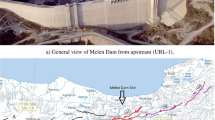Conclusions
Analysis of almost 20 years of experience with the use of roller-compacted concrete in dam construction enables us to conclude that in designing a concrete dam formed from roller-compacted concrete, it is always possible to calculate for the selection of optimal solutions, at least from a number of solutions that have been proven for other dams. Exposed trends and the most widespread conditions for use of roller-compacted concrete, including the procedural elements of its placement, require their own adjustment and adaptation in each design in conformity with the specific circumstances of the project. Despite the predominance of these trends, they should be referred to as critical, since dams formed from roller-compacted concrete are unique and should respond to specific conditions, and the selection of different solutions should correspond to technical requirements of the design. The most prevalent conditions under which roller-compacted concrete is used in dams should not therefore be considered universal; moreover, many other alternate schemes of structural and procedural solutions are also approved in actual practice.
The modern practice of constructing dams from roller-compacted concrete has accumulated a whole arsenal of proven solutions, which open broad possibilities and prospects for the design and construction of reliable structures. At the same time, it is not excluded that in a specific case, some controversial moments may arise where the placement of concrete in test blocks prior to the start of concreting for the dam will be required for its solution.
Similar content being viewed by others
References
L. A. Tolkachev, V. S. Shangin, K. K. Kuz’min, A. T. Oskolkov, V. B. Sudakov, E. A. Kogan et al., “Instructions for use of layer-by-layer (Toktogul) method of placing concrete in hydraulic construction,” in:Institutional Construction Regulation 06-74 [in Russian], Minénergo SSSR, Moscow (1974).
P. Londe and M. Lino, “The phased symmetrical hardfill dam: a new concept for RCC,”Water Power and Dam Construction (February, 1992).
M. R. H. Dunstan, “The state-of-the-art of RCC dams,”International Journal on Hydropower and Dams,1, No. 2 (March, 1994).
B. Wang, D. Wans, and Y. He, “Construction of the Puding RCC arch dam,”International Journal on Hydropower and Dams,1, No. 2 (March, 1994).
C. Shen, “New technical progress of RCC dam construction in China,” in:Proceedings of the International Symposium on RCC Dams, Vol. 3, 2–4 October 1995, Santander, Spain.
E. A. Kogan and V. E. Fedossov, “Roller-compacted concrete and strength of horizontal construction joints,” in:Proceedings of the International Symposium on RCC Dams, Vol. 1, 2–4 October 1995, Santander, Spain.
M. A. Franco and J. Y. Cordova, “The Spanish approach to RCC dam engineering,”International Journal on Hydropower and Dams (May, 1995).
E. K. Schrader, “Development, current practices, controversies, and options,” in:Reservoirs in River Basin Development: Proceedings of the ICOLD Symposium (Oslo, 6 July 1995), Vol. 2, A. A. Balkema, Rotterdam (1996).
M. R. H. Dunstan, “Recent developments in RCC dams,”International Journal on Hydropower and Dams,6, No. 1 (1999).
Additional information
Translated from Gidrotekhnicheskoe Stroitel’stvo, No. 5, pp. 30–40, May, 2000.
Rights and permissions
About this article
Cite this article
Kogan, E.A. Construction of dams formed from roller-compacted concrete. Analysis of state of the art and prospects for development. Hydrotechnical Construction 34, 243–254 (2000). https://doi.org/10.1007/BF02765973
Issue Date:
DOI: https://doi.org/10.1007/BF02765973




